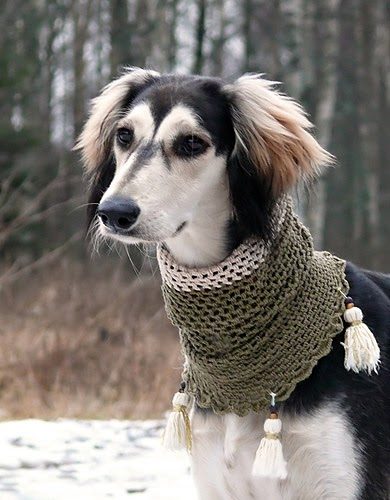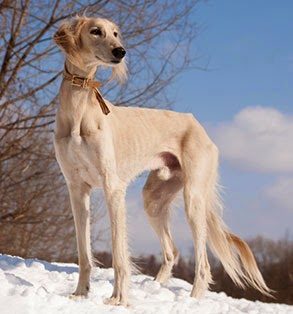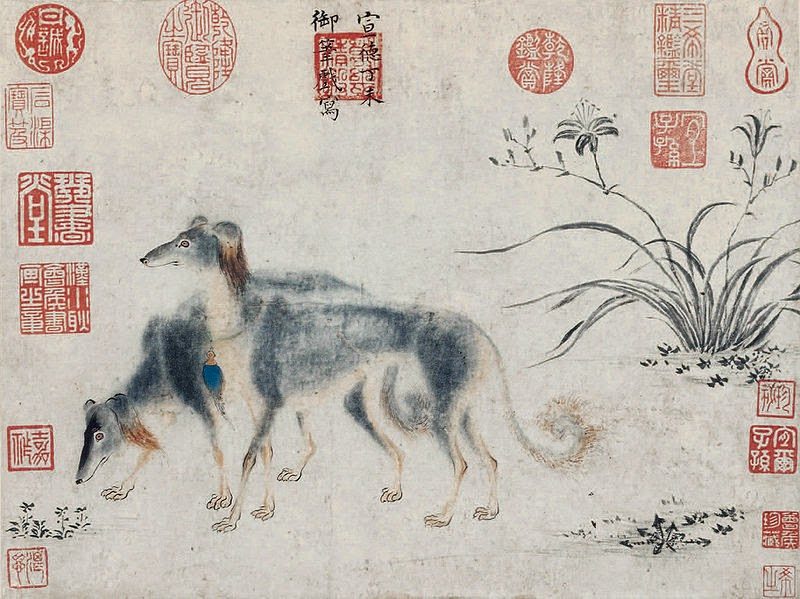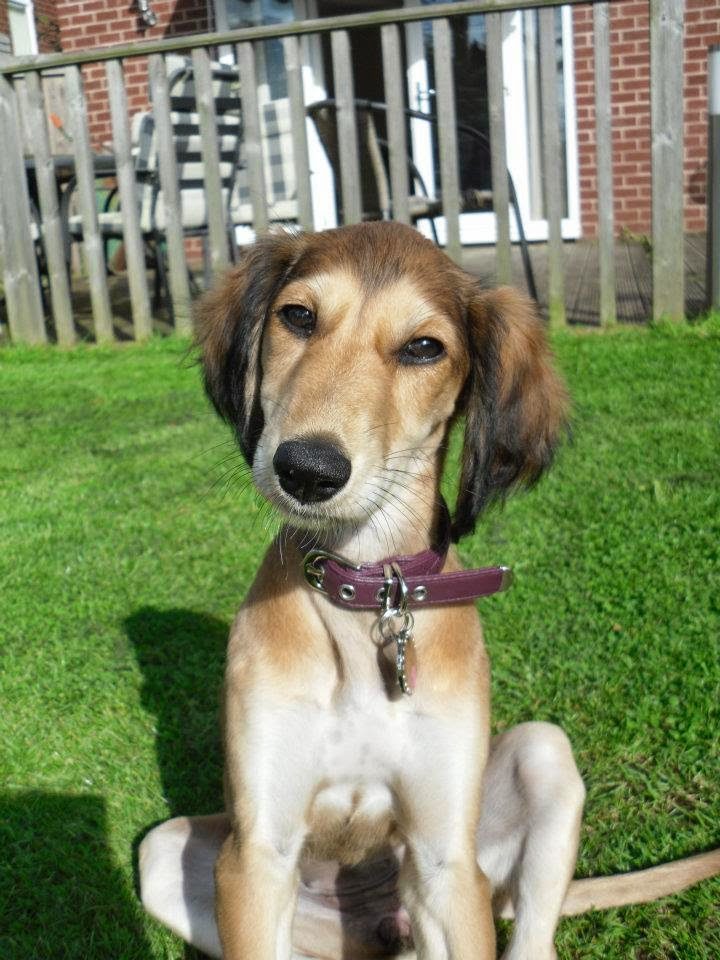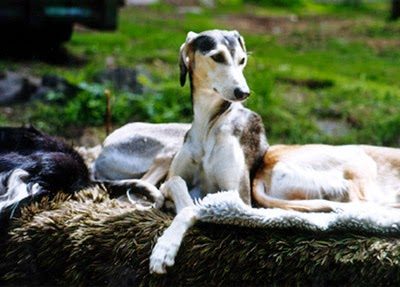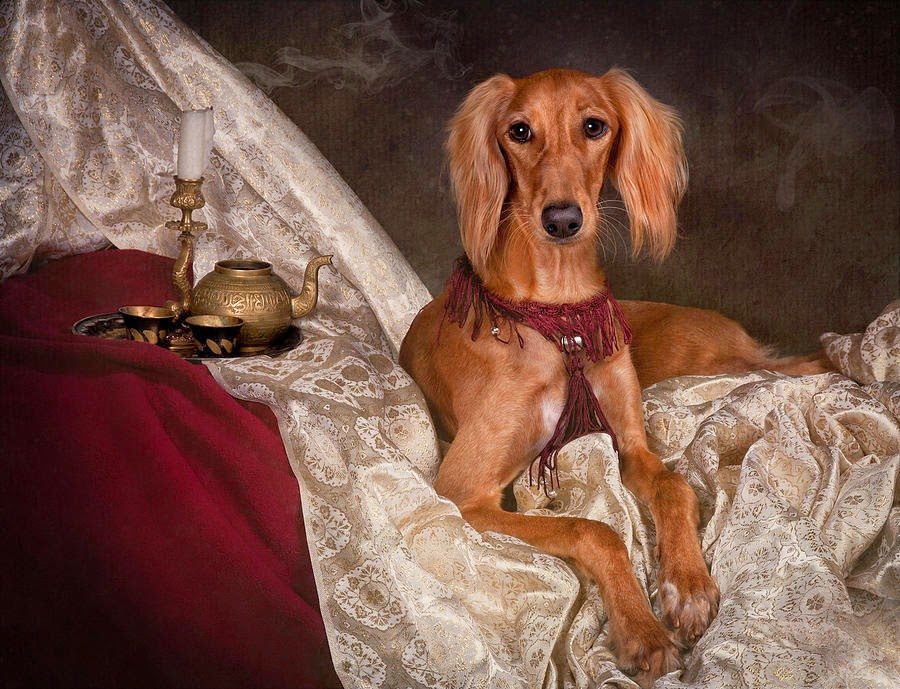Everything about your Saluki
This sighthound is a living antiquity. Known as one of the first domesticated breeds, the Saluki hails from Egypt. Highly respected, they were actually mummified like the Pharaohs! Later brought to the Middle East to hunt down gazelles, these graceful-looking dogs have a lot of power built into them. Referred to as a reserved and quiet breed, the Saluki is sensitive and gentle.
One of the oldest of dog breeds, Salukis were once considered a gift from Allah. They’re fast as the wind, skinny as a supermodel, and quietly devoted to their people. A Saluki is easy to groom, challenging to train, and not to be trusted off leash.
The Saluki is an elegant hunter with strong instincts to chase anything moving. He is a medium-size sighthound and can live happily in any environment, as long as he gets daily walks, maybe an opportunity to run a few times a week, and access to the sofa. His coat requires weekly brushing and sheds little. The Saluki is the world’s oldest dog breed.
Overview
The Saluki’s origins are shrouded in the sands of time, but his history is believed to go back to antiquity. He is the very definition of grace and speed, well deserving of the name bestowed on him by his Arab breeders — The Noble. The Saluki is bred for speed, strength, and endurance, qualities that are evident in his long, narrow head and sleek yet muscular body.
Beautiful but reserved, the Saluki is affectionate without being overly demonstrative. He’s happy to prove his loyalty through quiet companionship. Not everyone is offered the gift of a Saluki’s devoted friendship, but those happy few who receive it are appreciative of the honor.
Salukis are widely admired for their exotic appearance, but not everyone is well suited to live with this spirited and independent hunter. Any movement, be it a squirrel, cat, or radio-controlled car, will activate the Saluki’s instinct to chase, and his speed has been clocked at 30 to 35 miles per hour.
Unless he’s protected by a strong human on the other end of the leash or a securely fenced yard, he’s likely to meet his end beneath the wheels of a car. You might think that Salukis living in the country would have fewer issues, but they’ve been known to chase down and tangle with or kill goats, otters, foxes, raccoons, snakes, squirrels, and deer.
To keep a Saluki safe and well exercised, provide him with 300 to 400 lateral feet of fenced area where he can run full out. If your yard isn’t that large, you should have easy access to a fenced park, an enclosed sports field at a school, or a beach with no nearby road. On leash, the Saluki makes an excellent jogging companion — if you can keep up with him. He’s also a good competitor in agility and lure coursing. Some Salukis participate in obedience and tracking as well.
Indoors, the Saluki will make himself at home on your soft sofa or bed. He likes his comforts and needs cushioning for his somewhat bony body. Using his long, skinny muzzle, he’ll surf your kitchen counters in search of anything edible.
The calm and gentle Saluki can become timid and shy without early socialization and regular reinforcement through new experiences and introductions to many different people throughout his life. Generally quiet but alert, he’s a good watchdog, but not a guard dog. Salukis are fearless in the hunt but otherwise unaggressive.
Training a Saluki is possible, but don’t expect the perfect obedience you might have from a Golden Retriever. Salukis think for themselves, and if something else is more interesting than what you’re asking them to do, they’re perfectly happy to ignore you. Use positive reinforcement techniques such as food rewards and praise, never harsh verbal or physical corrections.
Salukis can make excellent companions for older children, but they aren’t recommended for homes with young children. They’re tolerant, but young Salukis can be too active for children younger than 8 years of age, and their thin skin and knobby bones make them vulnerable to injury if children aren’t careful.
While Salukis aren’t overly demonstrative, they do become strongly attached to their people and dislike being left alone for long periods. Consider a Saluki if you have time to give to a devoted, graceful friend who can run like the wind.
Breed standards
AKC group: Hound
UKC group: Sighthound
Average lifespan: 11-12 years
Average size: 35-65 pounds
Coat appearance: Smooth or feathered
Coloration: White, cream, red, golden, tan, black and tan, tricolor
Hypoallergenic: No
A Saluki is built of lines and curves, the very picture of grace and strength. He has a long, narrow head; long hanging ears covered in long silky hair; bright eyes that range from dark to hazel, with a far-seeing gaze; a long, supple, well-muscled neck; a deep but moderately narrow chest; long, straight legs; a broad back; strong hindquarters to power his ability to gallop and jump; moderately long feet with long, well-arched toes adorned with feathering; and a long tail feathered with silky hair and carried curved.
Salukis have a smooth coat with a soft, silky texture and a slight amount of feathering on the legs, the back of the thighs and sometimes on the shoulder. Some Salukis have a smooth coat with no feathering. They come in the colors of the desert: white, cream, fawn, golden, red, grizzle and tan, tricolor (white, black and tan), and black and tan.
Highlights
- Salukis love to run and need regular daily exercise.
- They must be kept on leash whenever they’re not in a securely fenced area. They have a strong prey drive and will pursue anything furry and in motion, heedless of their owner’s commands.
- Salukis are a reserved breed although they’re devoted to their people.
- Early and ongoing socialization is important for this breed to prevent shyness and skittishness.
- Salukis are not recommended for apartments. They require a large fenced yard where they can run safely. Underground electronic fencing is not recommended; their prey drive is so strong they’ll push past it.
- It is important to provide comfortable bedding for a Saluki since he doesn’t have enough body fat to provide padding.
- Salukis should not live outdoors. They thrive on human companionship and will become depressed if left alone for long periods.
- Although these dogs can make gentle and calm companions for older children, they are not recommended for homes with small children.
- Salukis are generally quiet dogs.
- When training a Saluki, be consistent, and use only positive reinforcement techniques such as food rewards and praise, since the breed is so sensitive.
- Salukis are fastidious and like to be clean. They shed little and require only weekly brushing.
- Salukis should not reside in homes that have small pets. Even with the best training, a Saluki will view small pets as prey and will try to hunt them.
- Salukis prefer the companionship of other Salukis, but they can get along with other dogs that do not have dominant natures.
- Salukis can be picky eaters.
- Never buy a Saluki from a puppy mill, a pet store, or a breeder who doesn’t provide health clearances or guarantees. Look for a reputable breeder who tests her breeding dogs to make sure they’re free of genetic diseases that they might pass onto the puppies and who breeds for sound temperaments.
Living Conditions
The Saluki is not recommended for apartment life. These dogs are relatively inactive indoors and will do best with acreage. This breed should sleep indoors. They prefer warm temperatures over cold ones.
Exercise
The Saluki is a natural athlete that needs a lot of exercise, including a daily, long, brisk walk or run. They are happiest when running, however many are lost or killed when they are allowed to get free and they spot a small animal to chase. This very independent dog can never be off its lead except in an isolated, scouted area. These dogs hunt on sight. They will pay no attention to their handler’s calls if they are chasing something. In some countries they are not permitted to be left off of their lead at all. Salukis run at top speeds of 55km/h or more with their feet barely touching the ground. These top speeds are reached in short spurts, but they also have exceptional endurance. An excellent way to exercise your Salukis is to let it trot alongside your bike.
Care
Salukis are not suited for apartment life. They need a home with a large, securely fenced yard where they can run flat out. The ideal running area for a Saluki is 300 to 400 feet in length or width. Fences should be at least five to six feet high or a Saluki will easily jump them. Underground electronic fencing will not contain a Saluki, nor will it protect him from other animals that might enter your yard.
Keep your Saluki on leash whenever he’s not in an enclosed area. A Saluki was bred for hunting and has a strong prey drive. If he sees anything fast and furry, he’ll pursuit it for as long as he can, disregarding any commands to come or stop.
Salukis are indoor dogs and require soft, cushioned bedding to prevent calluses from forming. Place food well out of reach of the Saluki’s inquiring nose. That means behind closed doors or up about seven feet.
Salukis are intelligent and learn quickly, but they’re also independent and can be stubborn, which makes training a challenge. To hold your Saluki’s attention, keep training sessions short, fun, and interesting. If a Saluki becomes bored, he will choose not to learn. Use positive reinforcement, never harsh verbal or physical corrections.
Grooming
The Saluki comes in two coat types: smooth and feathered. Brush the smooth coat weekly, but if you have the feathered variety, comb the feathering on the ears, tail, legs and feet at least a couple of times a week to prevent or remove mats and tangles, and bathe him as needed. At mealtime, you’ll probably want to put his ears up in a snood to keep them from dragging in his food dish. A water bowl with sides that slope inward at the top will help prevent the ears from getting wet when he drinks.
The rest is basic care. Trim the nails as needed, usually every week or two. Keep the ears clean and dry. Check them weekly for redness or a bad odor that might indicate infection. If the ears look dirty, wipe them out with a cotton ball moistened with a mild pH-balanced cleanser recommended by your veterinarian. Brush the teeth frequently with a vet-approved pet toothpaste for good overall health and fresh breath. Introduce your Saluki puppy to grooming from an early age so that he learns to accept it with little fuss.
Is this breed right for you?
Loving and extremely loyal, the Saluki can be a family pet; however, he may only attach himself to one owner. Not prone to roughhousing, it’s best that the Saluki is paired with families that have older children and someone that he can choose as his human. A great watchdog, the breed does not do well with animals that are not dogs. An athletic breed in need of large amounts of exercise, he’s not suited for apartment life and will make a great companion to a runner and biker.
Children and other pets
Salukis can make excellent companions for older children, but they aren’t recommended for homes with young children. They’re tolerant, but young Salukis can be too active for children younger than 8 years of age, and their thin skin and knobby bones make them vulnerable to injury if children aren’t careful.
They generally get along with other dogs, but prefer other Salukis, or at least other sighthounds. They won’t chase small dogs or cats in their own household, but other animals, such as pet birds, mice, rabbits, or hamsters could prove too much of a temptation.
Did You Know?
According to the Guinness Book of World Records the Saluki is the world’s oldest dog breed. They are believed to have originated in Egypt around 329 BC.
A dream day in the life of a Saluki
The Saluki will love to wake up to exercise. After a great run, he’s fine with being left alone at home for the day. Guarding the home is his No. 1 priority as he strolls the house and catnaps in his dog bed. After dinner, he’s ready to run alongside during a bike ride with his favorite human. He’ll enjoy ending his night with a treat and a bit of cuddling with his loving family.
